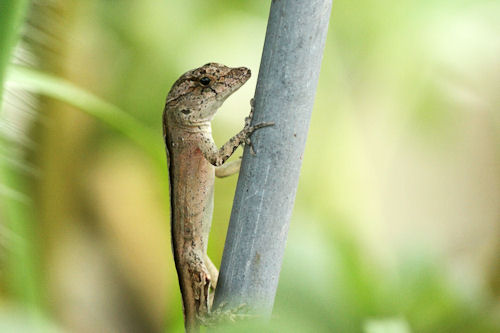In this afternoon’s round of lightning talks, anoles were the focus of three fantastic (but short!) presentations on adaptation. It’s not easy to summarize a whole project in five minutes, but that’s just what these three speakers did, and each left me wanting to know more!
First, James Boyko, a Masters student working with Luke Mahler at the University of Toronto, described his work on morphological evolution in Lesser Antillean anoles. When similar species compete over a shared resource, there are two possible outcomes: extinction or divergence (i.e., character displacement). Lesser Antillean anoles are an excellent system in which to study the role of character displacement, as these islands all have either one medium-sized species, or one large and one small species. Further, the species on these islands represent two colonization events – one from the north, and one from the south. James first confirmed the classic pattern on body size evolution, finding that a three peak Ornstein-Uhlenbeck model (i.e., one that predicted large and small lizards on two-species islands, and medium lizards on single-species islands) best fit the observed data (consistent with Butler and King 2004). But when he analyzed 20 other ecologically-significant morphological traits, this three peak model did not predict trait evolution better than a model based on random chance, although the northern and southern clades significantly differed in these morphologies. In summary, to understand the evolution of Lesser Antillean anoles: body size matters, as evolution in body size is clearly an important factor to reduce inter-species competition, but lineage matters too, as body shape was predicted by ancestry.
Next came Ann Cespedes, a Ph.D. student with Simon Lailvaux at the University of New Orleans. Ann is studying functional trade-offs in green anoles (Anolis carolinensis), focusing on relationships between fitness and performance. Many studies have searched for these trade-offs in the past, and some have found them, but others haven’t. Why the discrepancies? Ann proposed that previous studies haven’t always considered sex differences in functional trade-offs, that measuring only two traits (one associated with fitness and one with performance) may not reveal real trade-offs, and that differences in individual quality are often ignored. To consider all of these factors, she measured a suite of performance and morphological traits in 60 male and 60 female green anoles. Illustrating the limitations of examining raw data on sprint speed and endurance, Ann found no suggestion of the predicted trade-off between these traits. But when using a composite measure of all performance measures (sprint speed, bite force, clinging ability, exertion, endurance, jumping ability, and climbing ability) as a control for individual quality, the trade-off between speed and endurance became clear. Males and females also differed in their speed-endurance trade-offs, as body size predicted performance in different traits between the sexes, and body shape predicted male but not female performance. So performance trade-offs do exist, but you have to know how to look for them!
To conclude the session, Alexander Stubbs, a graduate student in Jimmy McGuire’s lab at the University of California, Berkeley, described the differences between opsin gene expression in two Cayman Island anoles: Anolis sagrei (a species with a red dewlap that reflects long wavelength radiation) and Anolis conspersus (a species with a blue dewlap that reflects short wavelength radiation). Alexander proposed that these different dewlap colors might provide different selective pressures on opsins in the two species to allow better color discrimination and angular resolution. Using RNAseq to measure mRNA in the eyes of six males of each species collected at solar noon or at sunset, the results were exciting. As predicted, Anolis conspersus had higher expression of opsins that increase visual sensitivity to UV, blue, and green wavelengths, and Anolis sagrei had higher expression of opsins that increase long wavelength sensitivity. Alexander also found that gene expression different substantially between noon and sunset, and further, there was surprisingly little variation in opsin expression between lizards, in stark contrast to the wildly varying opsin expression observed in humans.
 Stephen Jay Gould famously claimed that evolution is “utterly unpredictable and quite unrepeatable,” and we Anolis biologists have relished in proving that statement wrong. In his talk in Austin this week, Alejandro Gonzalez Voyer of UNAM (with coauthors Alvaro Dugo Cota and Carles Vilá) showed that anoles aren’t the only Caribbean herps to exhibit the independent, repeated evolution of ecomorphs across islands – Eleuthrodactylus frogs have joined the club!
Stephen Jay Gould famously claimed that evolution is “utterly unpredictable and quite unrepeatable,” and we Anolis biologists have relished in proving that statement wrong. In his talk in Austin this week, Alejandro Gonzalez Voyer of UNAM (with coauthors Alvaro Dugo Cota and Carles Vilá) showed that anoles aren’t the only Caribbean herps to exhibit the independent, repeated evolution of ecomorphs across islands – Eleuthrodactylus frogs have joined the club!












